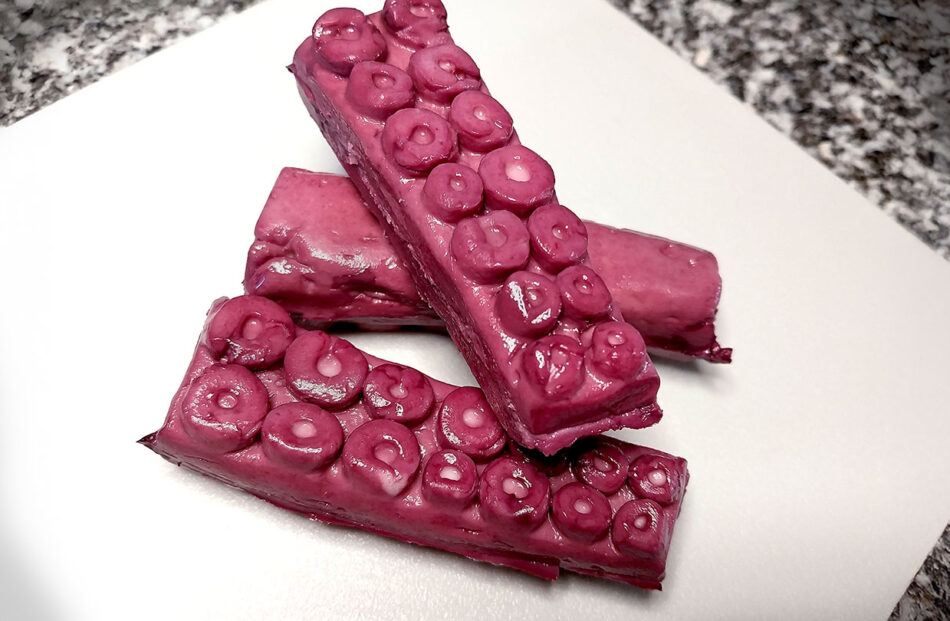Is this vegan octopus just a shockingly-shaped lump of mycoprotein, or a convincing, delicious seafood alternative? We put The Kraken to the test…
In the West, many of us aren’t used to seeing exotic sea life in supermarkets. So, products like this vegan octopus can seem unusual or even off-putting.
But having lived in Japan (and not being vegan at the time), I became accustomed to browsing past packaged tentacles and even whole, or occasionally partial, octopus heads and bodies during my weekly food shop. I’ve even bought a pack or two for ‘takoyaki nights’ back in my dormitory.
So, when I heard that Revo Foods had developed a vegan octopus alternative, I was thrilled at the idea of finally enjoying ‘true’ Japanese takoyaki again. Although, as I’d soon discover, they’re not as fun to make alone.
But opinions on The Kraken are divided. The product sold out within 48 hours of its initial limited-edition launch and was later reintroduced due to demand that was “too big to ignore.” Yet some critics have called its hyper-realistic appearance gross and a little over the top.
So, is The Kraken a serious addition to the vegan seafood market? Or just another log of generic plant-based protein, shaped to create shock factor? I put it to the test to find out.
Jump to:
The Kraken vegan octopus: product overview
Founded in 2021, Vienna-based startup Revo Foods is a pioneer in food processing technologies for mycoprotein-based protein biomass. This is the brand behind The Kraken, the world’s first fungi-based vegan octopus alternative.
The Kraken features a hyper-realistic tentacle shape complete with visible suckers and a chewy texture. Originally considered “too niche for mass production”, it launched experimentally as a limited edition in March 2024. However, to the Revo Foods team’s surprise, it sold out within 48 hours.
In the months that followed, Revo Foods was inundated with requests from customers, chefs, and retailers asking when The Kraken would return. Thanks to this unexpected enthusiasm, it’s now available to order directly from Revo Foods or through online retailers like Vegan Wholesaler.
Made from naturally fermented mushroom mycelium, this mycoprotein-based seafood alternative has earned a Nutri-Score of A, the highest possible rating. The packaging also asserts that the ‘tasty tentacles’ are high in protein and rich in omega-3 fatty acids.
While it can be eaten raw (for salads and cold dishes), Revo Foods recommends frying The Kraken for optimal flavour.
How does The Kraken taste?
As the saying goes, you eat with your eyes first, and The Kraken certainly makes an impression. Its tentacle shape can be a little unsettling at first, especially if you’re not used to seeing octopus as food.
The ‘suckers’ feel slightly odd when you first detect their shape with your tongue, but their texture is consistent with the rest of the tentacle, so it’s not too jarring. (If I recall correctly, real octopus suckers are chewier than the body and serve as a stark reminder of what you’re eating. Thankfully, that’s not the case here.)
To my delight, there was no strong whiff of seafood or fake meat when opening the pack. Instead, the smell is mild with perhaps a slight hint of ocean. It may have also been a little mushroomy, but not overpoweringly so, just a vague umami scent.
Revo Foods claims The Kraken can be enjoyed raw or cooked, so I tried both, and tasted the pan-fried version when hot and cold. Here, I kept it plain, with just a touch of vegetable oil for frying, but I later tried it in some classic octopus recipes, which you can read more about below.
It’s been a long time since I’ve eaten real octopus (well over a decade!), but the texture and taste aren’t far off, from what I remember.
The flavour is neutral with a subtle hint of seafood. It’s not particularly fishy, but lightly umami with a subtle shellfish-like flavour. I thought I also detected a faint undertone of mushroom, but that may just be because I was expecting it. I doubt even the most ardent mushroom-hater would be bothered by it.
In terms of texture, The Kraken feels like a home run. It has a chewy, realistic texture and a firm, bouncy bite without being rubbery or tough. It’s slightly gelatinous, which adds to the realism, but also has a fibrous structure, which makes it satisfyingly ‘meaty’ to bite into.
Pan-searing gives the vegan octopus a lightly charred appearance and a touch of crispness on the outside, though the overall texture doesn’t change much. Cooked, it was ever so slightly firmer, which I preferred. It also looks more appetising this way, so I’d recommend a quick sear even if you’re serving it cold.
One tentacle is enough for a light meal, so a single pack could serve three as a main, and may stretch further in side salads, rice dishes, or small plates such as takoyaki.
Meal test 1: Teriyaki noodles
For this dish, I was instructed to slice The Kraken into ‘rings’ for frying, which led me to expect a hollow structure. In reality, it’s a solid piece with sucker detailing on top, so there’s plenty of ‘meat’ in each piece.
Chopped up, it looks like it could be firm tofu or a seafood stick, if it weren’t for the sucker details visible on some of the chunks. It might not be easy to fool anyone into thinking it’s real octopus presented like this, but it looks convincingly seafood-like once incorporated into a dish.
It pan-fries beautifully, turning golden and glossy when coated in teriyaki sauce. The flavour of the vegan octopus works perfectly with this noodle dish, adding a subtle seafood note without overpowering the sauce. The texture is firm and pleasantly chewy, holding its shape and bite.
I found this to be a satisfying, realistic alternative. After this dish, I was eager to see what else I could do with the remaining tentacles.
Meal test 2: Pulpo gallego
For this Spanish-inspired dish, I followed a recipe from Revo Foods’ website. There were no measurements listed, which made it tricky, but it’s simple enough to follow if you’re used to eyeballing ingredients. The Kraken is really easy to cook whole like this, as it only needs a light sear in a pan to warm it through.
I only had bottled lemon juice, which meant the simple dressing in the recipe came out a bit dull, so I added a touch of vegan honey and some salt and pepper to balance the flavour.
The bright, citrusy dressing complemented the vegan octopus beautifully, enhancing its seafood flavour. It paired well with smoky, crispy potatoes.
Eating the tentacle whole was quite an experience. The suckers felt slightly strange again, but easy to get used to, and the texture overall was pleasantly chewy without being tough.
One tentacle was an ample enough portion to serve as a light meal or starter, but you’d want more for a filling dinner. I’d definitely make this again, especially as a clever way to use up leftover new potatoes.
Meal test 3: Takoyaki
It was finally time to make my most sought-after vegan Japanese recipe: takoyaki. This was the dish I was most excited about trying, and I even splashed out on a special pan to make them in.
When diced into small cubes, this vegan octopus alternative looked like a very realistic takoyaki filling. However, I’m rather out of practice at making takoyaki (not that I was ever fully in practice!), so they ended up looking a little dodgy. But that wasn’t The Kraken’s fault.
The distinctive texture of The Kraken stood out from other fillings like corn or vegetables, giving the takoyaki an authentic flavour and texture. It’s far more satisfying than an all-vegetable version.
I’ve tried professionally-cooked versions before, made with konjac to imitate the chewy octopus. While those are decent, I think The Kraken makes a much more convincing, enjoyable filling for takoyaki – but I’ll leave the actual cooking to the professionals.
Nutritional values
The Kraken provides 6.3 grams of protein and 122 kcal per 100 grams. It’s a minimally processed protein source with a complete amino acid profile and high nutrient bioavailability.
It’s also a source of DHA and EPA omega-3 from algae oil, so it’s a great seafood alternative nutritionally, as well as gastronomically.
In fact, The Kraken offers double the total omega-3 of real octopus, without the mercury contamination or the guilt of eating an intelligent, sentient animal capable of solving complex puzzles.
Ingredients in The Kraken
While the ingredient list is relatively clean, some ultra-processed food avoiders might take issue with the gelling agents used. Personally, I think these are essential for achieving the distinctive texture of this vegan octopus, so I’m happy to overlook them.
Full ingredients:
- 48% Mycoprotein (Fusarium venenatum)
- Water
- Rapeseed oil
- Gelling agents: carrageenan, methylcellulose, konjac, gellan gum
- Modified starch
- Natural flavours
- Sea salt
- DHA and EPA-rich oil from microalgae (Schizochytrium)
- Acidifiers: lactic acid, calcium lactate
- Carrot and blueberry concentrates
The final verdict
I was pleasantly surprised by The Kraken’s flavour and texture. Having been let down by vegan seafood alternatives before, finding one with an authentic (but not stomach-turning) texture and a balanced, realistic flavour was a relief.
Visually, The Kraken is striking — perhaps too much so for some. But once you get past the eerie realism of its suckers, it’s a clever, versatile product that looks impressive on the plate.
It’s niche and relatively pricey, but then again, so is real octopus. At roughly £2 per tentacle, it’s not unreasonable as an occasional treat, especially when used creatively across dishes.
Overall, I was pleasantly surprised to find that The Kraken is a genuinely innovative product with impressive taste and texture. I’d happily buy it again, and I’ll certainly keep an eye out for it on restaurant menus.
Interested in more seafood alternatives? Try these convincing vegan fish recipes
Featured photo © Vegan Food & Living








